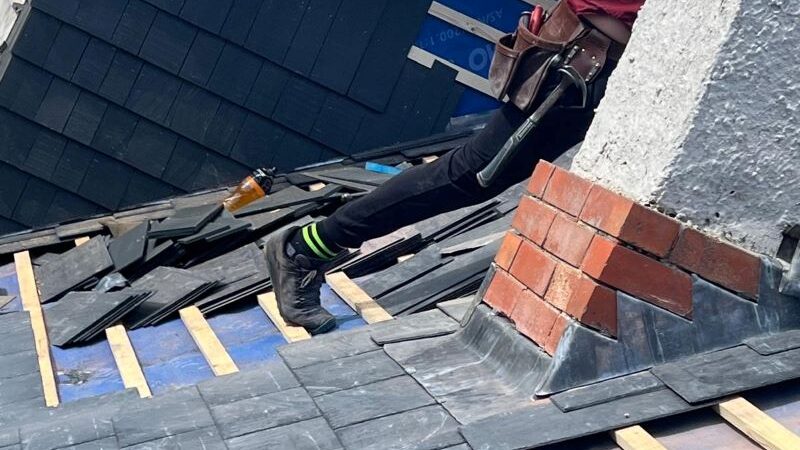Enhance Your Slate Roof's Durability with Effective Flashing to Prevent Costly Water Damage
Flashing serves as an essential protective barrier at the most vulnerable junctions of your roof, particularly where tiles connect with walls, chimneys, or valleys. Without appropriate flashing, even a meticulously installed slate roof can suffer from leaks, leading to expensive repairs over time. Lead is preferred for flashing in slate roofing applications due to its flexibility, exceptional durability, and inherent ability to accommodate the natural movements of the roof structure, ensuring a secure seal that effectively prevents water penetration.

What Is Flashing and Why Is It Crucial for the Integrity of Your Slate Roof?
Flashing refers to the critical material used to seal joints and edges around various structures, such as chimneys, skylights, roof valleys, and any transition points where your slate roof intersects with a wall or alters direction. These joints are particularly susceptible to water infiltration; hence, without effective flashing, they can quickly become problem areas that lead to leaks. In contemporary building practices, flashing may be crafted from sheet metals, yet for traditional slate roofing, lead remains the superior material.
Why opt for lead? This material not only creates effective seals but also adapts to form a strong barrier against varying curves, slopes, and edges. Its natural capacity to expand and contract with temperature fluctuations prevents cracking or splitting. Unlike synthetic alternatives, lead is resistant to rust and maintains its integrity for much longer, often outliving the slate itself.
What Are the Consequences of Improper Flashing Performance?
Even a minuscule tear or gap in your flashing can trigger significant leaks. These leaks are rarely straightforward; water can seep beneath the tiles, reach the underlay, and gradually lead to severe issues such as rot, mould, or damage to your internal ceilings. The effects of flashing malfunction may not be immediately apparent, frequently taking years to surface, and by this time, repairs can escalate into extensive and costly undertakings. Problems associated with flashing are among the primary causes of concealed roof failures.
If you observe stains on your ceiling, bubbling paint around a chimney, or patches of moss accumulating in specific areas on your roof, it is likely that deteriorating flashing is to blame.
Why Is Lead Considered the Best Material for Flashing Applications?
For centuries, lead has been the material of choice for slate roofs, thanks to its remarkable properties. It is recyclable, incredibly durable, and can withstand extreme weather conditions, whether enduring high heat or severe storms. The malleability of lead allows it to fit snugly without risking damage to the delicate slate, which is notably more fragile in comparison.
Common applications for lead flashing encompass:
- Chimney flashings (both step and apron)
- Roof valleys
- Secret gutters
- Roof-to-wall junctions
- Ridge and hip intersections
- Skylight surrounds
These areas experience significant movement, pressure, and water runoff, making them susceptible to failure if rigid, inflexible materials are used that may crack or detach.
When Should You Consider Repairing or Replacing Your Lead Flashing?
Although lead flashing is generally long-lasting, it will inevitably deteriorate. You should contemplate replacement if:
- The lead has developed cracks or splits
- It is lifting or curling away from the roofline
- Rust is visible, particularly where lead interfaces with other metals
- Water stains are apparent inside your home
- You are already planning a slate roof repair or reconstruction
Most slate roof restorations entail a comprehensive examination of all leadwork. If our team is already on your roof for tile replacement or cleaning, that presents an ideal opportunity to inspect and replace flashing as needed.
Why You Should Rely on Skilled Craftspeople for Leadwork
Leadwork is a specialised craft that should not be entrusted to a general roofer or handyman. Improperly installed lead can sag, split, or detach from the slate, undermining the advantages of a well-constructed slate roof. Our team uses traditional techniques for installing lead flashing, ensuring proper sizing, correct lap joints, and expansion joints that can adapt to the weather fluctuations commonly experienced in Sydney. We are committed to using lead only where it is the most suitable material for each specific job.
How Quality Flashing Can Prevent Future Roofing Complications
A slate roof can endure for a century or more, but this longevity is only achievable if its most vulnerable points are adequately safeguarded. Flashing and leadwork may not be the most glamorous aspects of a roof, yet they are fundamental components that bear the brunt when weather conditions turn severe. If you observe leaks, streaks, or signs of deterioration around your chimney or roof edges, it is imperative to have these issues evaluated promptly. Replacing flashing now can save you from incurring much higher repair costs for structural damage later.
Are You Seeking a Professional Inspection for Your Leadwork?
If your slate roof features flashing that has seen better days or is exhibiting signs of wear, it is prudent to have it inspected before minor issues escalate into substantial damage. Contact us today to schedule an inspection with a team that understands slate, lead, and the intricate details that effectively maintain the integrity of your roof.
Frequently Asked Questions About Flashing and Leadwork in Slate Roofing
What is flashing on a slate roof and why is it crucial?
Flashing is the material utilised for sealing joints and transitions in the roof—such as around chimneys, valleys, and skylights—preventing water from penetrating the roofing structure.
Why is lead the preferred material for slate roof flashing?
Lead is flexible, highly durable, and resistant to weather extremes. It fits the contours of slate tiles and outlasts synthetic materials, making it the ideal choice.
How long can you expect lead flashing to last under normal conditions?
With proper installation, lead flashing can last for 50 years or more, frequently outlasting the slate roof it protects.
Is it possible to repair flashing without a complete roof replacement?
Indeed, damaged or worn flashing can be repaired or replaced without necessitating a full slate roof replacement, provided the problems are addressed in a timely manner.
What signs indicate flashing failure?
Indicators of flashing issues include water stains near chimneys, damage to ceilings, moss growth in isolated areas, or visible gaps where roof surfaces meet.
Do all slate roofs require lead flashing for effective protection?
The majority of slate roofs do require it. Areas such as chimneys, valleys, and wall junctions necessitate flashing, with lead being the preferred material due to its compatibility with slate.
Is it safe to use lead flashing in residential properties?
Yes, when installed by professionals, lead flashing poses no safety risks. It remains the most effective and traditional choice for slate roofs.
The Article: Leadwork and Flashing: Why It’s Crucial for a Slate Roof first appeared on https://writebuff.com
The Article Leadwork and Flashing: The Importance for Slate Roofs Was Found On https://limitsofstrategy.com

